NEW Raylectron v2, a photorealistic SketchUp render plugin.
-
We would like to introduce you with our new photorealistic rendering plugin for SketchUp.
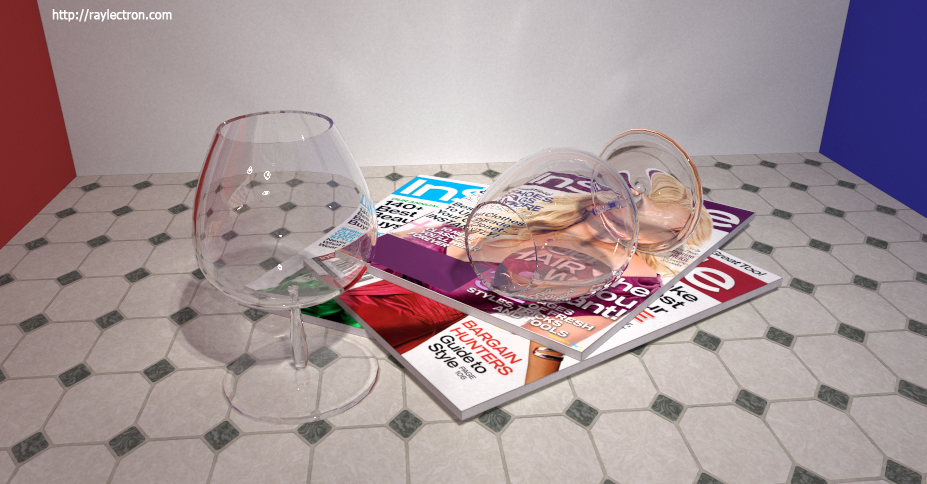
Raylectron v2.00
Size: 1,9 MB
Price: $99.95 USD
OS: Win7 x32,Win7 x64,WinServer,WinVista,WinVista x64,WinXP
Program type: Shareware
Limitation: Full working copy, embedded watermarks.Raylectron v2, a photorealistic SketchUp render plugin.
An affordable, easy and powerful Sketchup rendering plugin and its only limitation is memory. In 64 bit mode, you can virtually create rendered images of any size.
It provide the user with 4 different rendering mode. Depending on the scene being rendered, one can use Raytrace with true shadows, Path tracing with or without direct illumination and Photon mapping.
Each creating a unique effect. There is also 4 types of light source. The sun, the sky, environment maps and any materials set as a light source (emitter) with settings for the power and coverage angle.
Any materials can produce different effects, such as reflection (like mirror), refraction (like glass), transparency, glossiness, shininess, bump maps, normal maps and background images. Shadows are not fake or simulated like "Soft shadows". Caustics are also real, not fake or simulated.
Raylectron utilize all the CPU cores and threads (user selectable) to render as fast as possible. It is also possible to install Raylectron on remote computers (even on the Internet) and use them as slaves. Slaves do not send any data back as it renders, instead, the data is sent when you request to update the "View port" on the master. This makes is so efficient that you could have a large number of slaves running and virtually no network traffic.
Raylectron support HDR maps and can save the rendered image as an HDR to further process it using an image editor such as Photoshop, you can also save in jpg, png and many other formats.
Raylectron already contain just about all the settings you need to fine tune the output, therefore, no further processing by other software is required.
The rendering process happens outside of Sketchup so that you can continue working on your model while the render is going.
You can also stop the render, save it, reopen it later and resume the render.
You can rotate, pan, zoom and modify your materials and lights right from the Raylectron
 viewer.
viewer.No need to remove walls to see the interior render, simply use the X-Ray vision.
You can render Stereo Vision and render OBJ files.
The Raylectron Sketchup plugin is a great tool for a Building Architect, Landscape Architect, Interior Designer, Builder, General Contractor, Educational, Inventor, hobbyist, amateur, or anyone with 3D designs who which to turn their models into photorealism presentations, and/or to view their models in 3D stereo to view them as if they are real.
Site URL:
http://raylectron.com/Other Screenshot:
http://raylectron.com/images/Scene415.pngDirect download:
http://raylectron.com/Raylectron_Setup_Win64.exe
http://raylectron.com/Raylectron_Setup_Win32.exeFeedback is welcome.
Thanks. -
Im surprised this has no replies?
Ill be trying this at work tomorrow. Its all down to render speed for me... -
@mrmikeesq said:
Im surprised this has no replies?
Ill be trying this at work tomorrow. Its all down to render speed for me...It was only posted today the 6th, not the 2nd!
If you want speed with Raylectron, use the Raytrace mode, it's very fast and isn't using the GPU, only the CPU.
Here's one with 4 lights I just did (927x484) using raytrace mode, it took less than 2 mins using 4 cores 3GHZ...
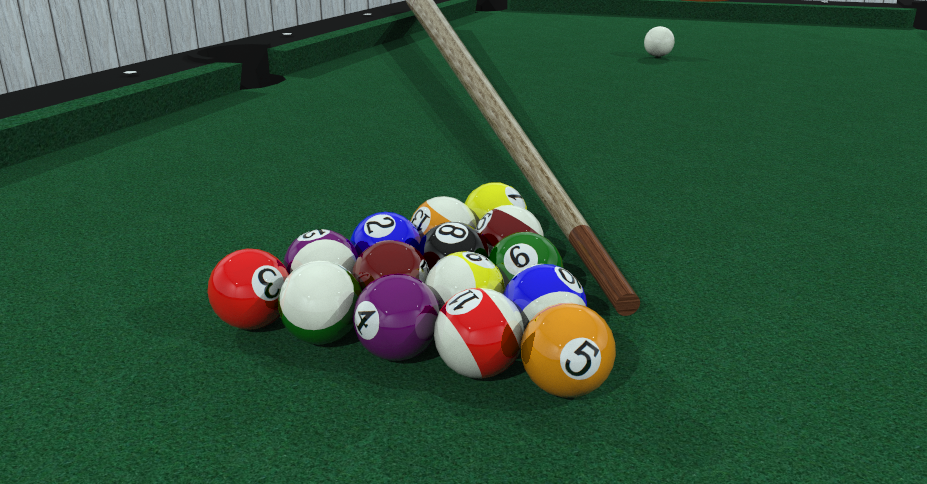
And if you want even more speed, use other machines on your network if you have any.
-
Interesting. The price is good but for the same price you can get Twilight Render and Maxwell for SU which are using known and mature render engines. Apart from the network abilities are there any other significant advantages of Raylectron over the other render plugins of the same price?
When was Raylectron V1 released? Your website seems new and your forum is mostly empty (and this was your first post here
 )
)@unknownuser said:
Limitation: Full working copy, embedded watermarks.
No time limit?
-
@zoom123 said:
Interesting. The price is good but for the same price you can get Twilight Render and Maxwell for SU which are using known and mature render engines. Apart from the network abilities are there any other significant advantages of Raylectron over the other render plugins of the same price?
When was Raylectron V1 released? Your website seems new and your forum is mostly empty (and this was your first post here
 )
)@unknownuser said:
Limitation: Full working copy, embedded watermarks.
No time limit?
What makes you say that Raylectron doesn't wseem to use "mature render engines"?
Yes there are many other advantages. But it depend on what you need and how you work. Not everyone want the same thing. Some like lots of complex settings, some don't like that at all, hence the competition. I'm not trying to make Raylectron the best taste of all renders. It's just another product like the others, some like it, some don't.
It's been around for a year, and the board was taken down not long ago because of too much spam, and it was old, CGI driven, no SQL, and now the new board is PHP and nothing was transferred.
No limit, just a watermark. Unlike others, not network limit either.
-
I tried it on a quick interior I'd made before. It has 4 small down lights. It lit the room fine but the ceiling itself was black? Or mostly black. Seemed like very hard shadows with very linear lighting, which I assume you can tweak but couldn't work out how
-
@unknownuser said:
Yes there are many other advantages.
What are the other major advantages when compared to the other programs in the same price range?
@unknownuser said:
No limit, just a watermark. Unlike others, not network limit either.
Sounds good!
-
The render output looks pretty good but like others I don't see anything that would make me choose this program over the competition.
Two things I would like to see:
Support for pre-made material libraries, no one wants to reset materials every time they make a new file.
IES light profiles, for me this is a must for accurate architecture rendering. -
@mrmikeesq said:
I tried it on a quick interior I'd made before. It has 4 small down lights. It lit the room fine but the ceiling itself was black? Or mostly black. Seemed like very hard shadows with very linear lighting, which I assume you can tweak but couldn't work out how
Have you clicked on the "Tone mapping" setting?
If you used Raytrace mode, there is a number of reasons why the ceiling is almost black. The "ambient range" (in Camera settings) should be the longest "line" length that would fit in that room. For example, a 16'x16'x8' room has a 24' max line length that can fit in it (from corner to corner in diagonal). Then the ambient multiplier to brighten or darken the shadows. In raytrace mode, lights always produce hard shadows. But if you uncheck Raytrace and use "Direct illumination", you will have much better result for shadows. Same if you use photons.
Here's a quick raytrace with 12 lights on the ceiling and a fireplace, then the same scene rendered using photons...
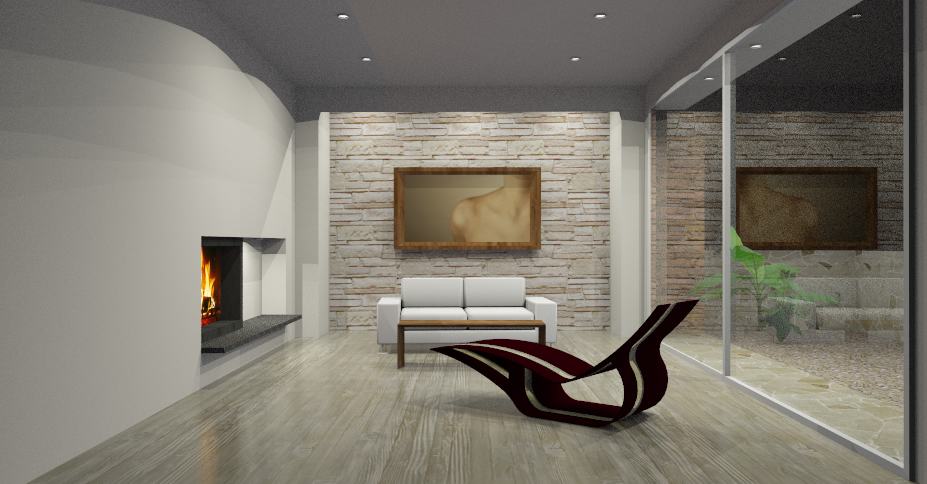
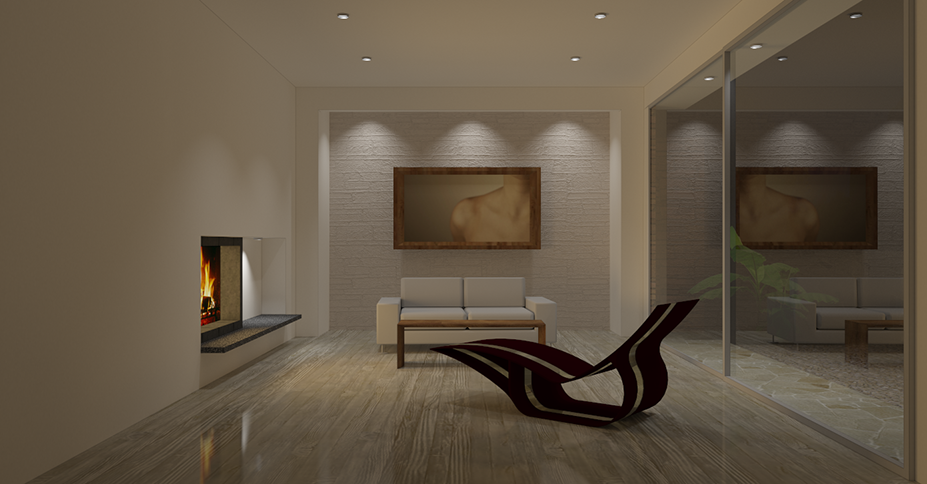
-
@zapwizard said:
The render output looks pretty good but like others I don't see anything that would make me choose this program over the competition.
More than one tool is better than a single one. We are by no mean trying to make anyone switch.
One big thing to know about Raylectron is, you can stop the render, edit your materials and lights, zoom pan etc. then render. No need to re-export the whole model again and wait for it to load the export file etc.
@zapwizard said:
Two things I would like to see:
Support for pre-made material libraries, no one wants to reset materials every time they make a new file.
IES light profiles, for me this is a must for accurate architecture rendering.On the works already.
-
Ill have another attempt tomorrow, was rushing today. One thing I hate about podium is the annoying light anomalies/patches. This seems to be at a similar difficulty level so if its better i may switch
-
@mrmikeesq said:
Ill have another attempt tomorrow, was rushing today. One thing I hate about podium is the annoying light anomalies/patches. This seems to be at a similar difficulty level so if its better i may switch
We've lost all our help section on our site, and we are redoing it. So feel free to ask any questions. Many features are not documented yet.
@zoom123 said:
Interesting. The price is good but for the same price you can get Twilight Render and Maxwell for SU which are using known and mature render engines. Apart from the network abilities are there any other significant advantages of Raylectron over the other render plugins of the same price?
I've ran a render using Raylectron, Podium, Twilight and Maxwell, all ran under a few minutes and here are my results...
Sketchup model:
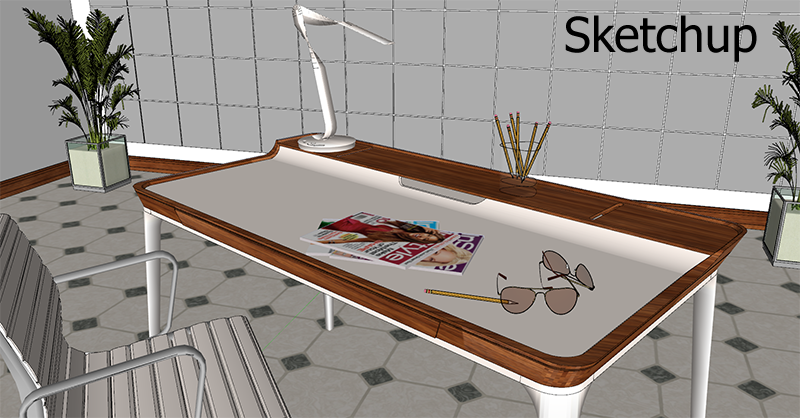
Raylectron render: (raytrace mode only, light source is a simple white square set as an emitter)

Twilight render: (light source is an IES light, weird glass colors! Floor shifted!)
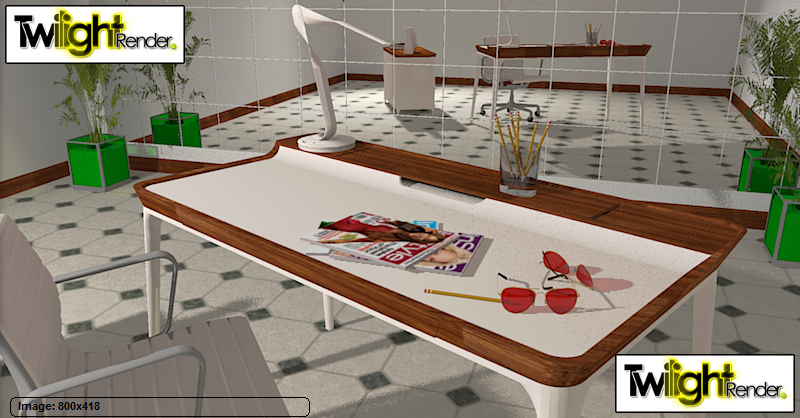
Podium render: (couldn't get it any nicer!)
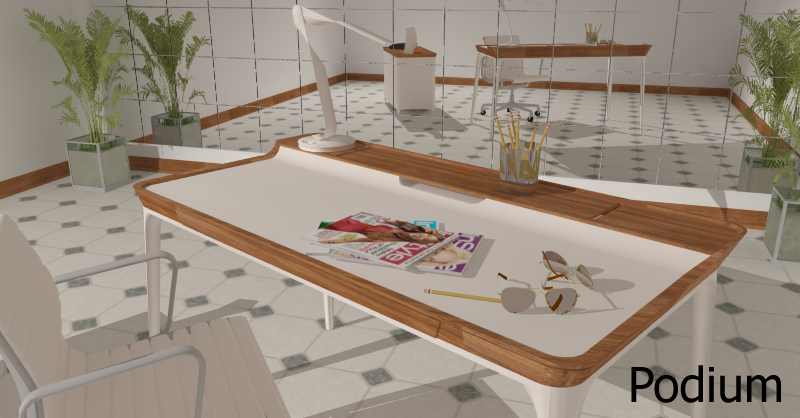
Maxwell render: (I couldn't get that one to work!)

In all, Raylectron was faster to produce the result, even if the actual render time was a little bit slower than Twilight and Podium. The reason was, I spent most of my time adjusting lights and re-render the whole thing. In Raylectron, it was easy to set the lights. Stop, change setting, Start, until I have it right, and while rendering, I can adjust Tone Mapping and everything else, 30 secs and done. Twilight, Podium and Maxwell, I had to make the changes in Sketchup and re-export. In Raylectron, I use the light editor outside of Sketchup, no need to re-export nor reload anything. Also, anti-alias was best in Raylectron. Look at the back wall and you'll notice.
-
I feel that I have to support Zoom123's opinion. Especially in Twilight Render aspect. From Twilight you can export XML for Kerkythea and use the BOOST version which have huge speed improvement, especially on x64 machines. Also, as I could see on your screenshots, the material editor doesn't have preview. Indeed, I haven't tried it yet, but to compete with the existing rendering engines is not enough just to have a "comparable result"... it needs to come up with something. Look at Maxwel Render, is by far the slowest unbiased rendering engine... but also, the most realistic one and the materials are created in a intuitive mode, that allows to copy almost anything you find around you. Also, there is that multilight editor which can produce astonishing effects with only one rendered image!
I don't want to run down your rendering engine, far from me this thought. Actually I'm glad to see new software that come to compete the existing ones... but, as I said before, the software must come in front with something... let it be the price, the interface (Twilight Render conquered the market with a very simple yet powerful interface), let it be the speed, or the flexibility ... I don't know... as I can see now, I'm not very tempted. And for the same price, I can find another (better) one.
I'm not sure where I could use a stereo rendered image, I never used such, please give me a hint.
What I like, is the possibility to resume a render.Good luck !
-
@unknownuser said:
I feel that I have to support Zoom123's opinion....snip...
Criticism is good for improvement, so I thank you for that, and thanks for the "Good Luck"
 . But, it is rather too early for you to make such judgment "I can find another (better) one" as you never tried the software. Each are good in their own way, depending on what you render. There are no "better one". They are all good.
. But, it is rather too early for you to make such judgment "I can find another (better) one" as you never tried the software. Each are good in their own way, depending on what you render. There are no "better one". They are all good.One feature I'm sure you'd love to have is the X-Ray. When you want to render a room for example, you always have to place the camera in a corner and set the FOV to high number to get a fish-eye view, or, remove a wall. Not very practical. In Raylectron, you don't need to corner the camera nor do you need to remove walls. Just use X-Ray, and you'll render through the walls while keeping the walls in the render such as in mirrors and everything else.
You can edit your material and lights right from Raylectron. Edit, preview, stop, edit, preview stop, etc. Set the viewport to the size you want your preview, and it's easy and simple. Materials react differently in different environment, so a preview with white surrounding is not always accurate.
Just like anything else, you need to get use to it, know it. Use it for a while, then you'll see what's wrong and what's good, and, if you like it or not.
-
@unknownuser said:
I'm not sure where I could use a stereo rendered image, I never used such, please give me a hint.
Try it on a 32" monitor full screen. It's better than life itself. Better than 3D glasses.
Of course, the only place you can use it is, in your head, since you're the only one that can view it in stereo. Not useful you may say? Why does it have to be!
-
@unknownuser said:
I've ran a render using Raylectron, Podium, Twilight and Maxwell, all ran under a few minutes and here are my results...
I won't bother to comment on those render "results" but maybe for fairness you could post the test scene for others to play.
-
Care to share that model? that way experienced users of Twilight, Podium and Maxwell can test it and have a proper comparison, I believe yours have been done with a certain bias.
-
@solo said:
Care to share that model? that way experienced users of Twilight, Podium and Maxwell can test it and have a proper comparison, I believe yours have been done with a certain bias.
I will be providing it on our forum when I have it all finished (fixing defects etc.). Objects used are from the 3D warehouse. Anyone can simply make a 16'x16'x8' room, white walls and ceiling, 12x12 mirrors on the back wall, and a few furniture, a light at the top left corner behind the cam, and that's it.
"...certain bias"? Strictly raytrace, no photon, no path tracer.
-
@unknownuser said:
"...certain bias"? Strictly raytrace, no photon, no path tracer.
I guess Pete meant that youwere not unbiased, not the rendering method.
-
@gaieus said:
@unknownuser said:
"...certain bias"? Strictly raytrace, no photon, no path tracer.
I guess Pete meant that youwere not unbiased, not the rendering method.
Indeed!
Advertisement







